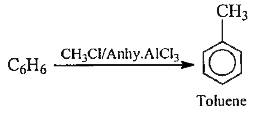The product of which of the following reactions has the highest ease to undergo electrophilic substitution? C6H5COClPd/BaSO4−−−−−−→, C6H6Cl2/FeCl3−−−−−−→, C6H6CH3Cl/Anhy.AlCl3−−−−−−−−−−−−→, C2H5OHconc.H2SO4−−−−−−→Solution in Malayalam
C6H5COClPd/BaSO3−−−−−−→
C6H6Cl2/FeCl3−−−−−−→
C6H6CH3Cl/AnhyAlCl3−−−−−−−−−−−→
C2H5OHConc.H2SO4−−−−−−−→
The correct Answer is:C
Product of reaction given in option (C) is, as 
−CH3 group in toluene, activate the benzene nucleus towards electrophilic substiution due to its elecron releasing nature.
Topper's Solved these Questions
- BOOK - BRILLIANT PUBLICATIONCHAPTER - ISOMERISM AND REACTION MECHANISMEXERCISE - LEVEL - III8videos
ISOMERISM AND REACTION MECHANISM
- BOOK - BRILLIANT PUBLICATIONCHAPTER - ISOMERISM AND REACTION MECHANISMEXERCISE - LEVEL - III (Multiple choice answer type)15videos
ISOMERISM AND REACTION MECHANISM
- BOOK - BRILLIANT PUBLICATIONCHAPTER - ISOMERISM AND REACTION MECHANISMEXERCISE - LEVEL - III (Linked Comprehension Type) (Paragraph III )3videos
ISOMERISM AND REACTION MECHANISM
- BOOK - BRILLIANT PUBLICATIONCHAPTER - HYDROGENEXERCISE - LEVEL -III ( Linked Comprehension Type)8videos
HYDROGEN
- BOOK - BRILLIANT PUBLICATIONCHAPTER - ORGANIC CHEMISTRY : SOME BASIC PRINCIPLES - PART I (NOMENCLATURE) EXERCISE - LEVEL-III45videos
ORGANIC CHEMISTRY : SOME BASIC PRINCIPLES - PART I (NOMENCLATURE)
Similar Questions
Equal amount of an RCl(C4H9Cl) is reacted at the same temperature with equal volume of 0.2 Mand 0.4M. solution of KOH, respectively, in two separate experiments. The time taken for the reaction of 50% of (C4H9Cl) was found to be same, the alkyl halide is:
02:40View SolutionWhich of the following are S2N reactions?
03:12View SolutionWhich of the following is most basic?
03:37View SolutionThe volume of 10 volume H2O2, solution that decolourises 200 ml of 2NKMnO4, solution in acidic medium is:
02:58View SolutionGive the IUPAC name of the following compound:
 09:19View Solution
09:19View SolutionName the following reaction. C_(6)H_(5)-C-=N overset(SnCl_(2)+HCl)rarr C_(6)H_(5)-CH=N^(o+)H_(2)]Cl^(Θ) overset(H_(2)O)rarr C_(6)H_(5)CHO+NH_(3)
02:48View SolutionFor the reaction C_(6)H_(6)+(CH_(3))_(2)CHCH_(2)Cl overset("Anhy".AlCl_(3))rarr The final product is
02:04View Solutionअभिक्रिया, C_(6)H_(5)Cl + 2Na + C_(6)H_(5)Cl overset("ईथर")rarr C_(6)H_(5)-C_(6)H_(5) + 2NaCl, निम्नलिखित का एक उदाहरण है -
03:07View SolutionC6H6+AAlCl3−−→C6H5CONH2
A in the above reaction is :03:18View SolutionFill in the blanks with appropriate structures of reaction products in the following transformations Ortho - HOOC - C_(6)H_(5) - CH_(2) - C_(6) H_(5) overset(SOCl_(2))(rarr) G G underset(AlCl_(3))overset("anhydrous")(rarr) H " " H underset("HCl")overset(Zn - Hg )(rarr) I o - HOOC - C_(6)H_(4) - CH_(2) - C_(6)H_(5) overset(SOCl_(2))(rarr)
02:49View Solutionनिम्न अभिक्रिया में मुख्य उत्पादों को ज्ञात कीजिए
(i) C6H6+(CH3)2CHCH2OhH2SO4−−−→ ………..
(ii) C6H5C2H5(i) Br2,Δ,प्रकश−−−−−−−−−−→(ii)NaCN ..............02:24View SolutionC_(6)H_(6) + CH_(3)Cl underset(AlCl_(3))overset("Anhy.")rarr C_(6)H_(5)CH_(3) + HCl It is an example of
View SolutionIn the reaction : C_(6)H_(6) + RCOCl overset(AlCl_(3))rarr C_(6)H_(5)COR + HCl the attacking electrophile is :
View SolutionGive the main products of the reactions :
(a) C6H6HNO3−−−→H2SO4
(b) C6H5CH3CrO2Cl2−−−−→
(c) C6H5CH2CH2CH3Alk.KMNO4−−−−−−−→
(d) C6H6+Cl2sunlight−−−−→
(e) C6H6+CH3COOClAnhyd.AlCl3−−−−−−−→02:17View SolutionIdentify the electrophile and nucleophile in the following reactions :
(a) C6H5N2Cl+KI→C6H5I+KCL
(b) C6H5N2Cl+C6H5OH→C6H5N=N−C6H4OH
(c) C6H5N2Cl+CH3OH→C6H5OCH3
(d) C6H5N2Cl+H2O→C6H5OH03:13View SolutionIdentify the electrophile and nucleophile in the following reactions :
(a) C6H5N2Cl+KI→C6H5I+KCL
(b) C6H5N2Cl+C6H5OH→C6H5N=N−C6H4OH
(c) C6H5N2Cl+CH3OH→C6H5OCH3
(d) C6H5N2Cl+H2O→C6H5OH01:51View Solution

